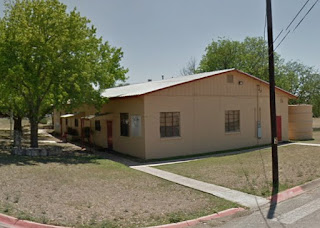 |
| Kerrville Athletics, from the Kerr County Historical Commission Collection |
My purpose on this blog has been to tell the stories of the built
environment in Kerr County. I have tried to focus on the histories of
the buildings and man-made objects that still exist in the county. But I
have found an interesting story about a place that no longer exists,
and I don't want to ignore it because of a self-imposed rule.
So today we have a picture of a baseball team rather than the ball park they played on. The story of that team follows, but first ...
I was fascinated to read that the New York Giants and
the Chicago White Sox played here in an exhibition game to benefit
Legion Hospital on March 19, 1930. They were in spring training in San Antonio. They took the train from San
Antonio, visited at Legion Hospital, lunched at the Blue Bonnet Hotel,
played the game, then returned to San Antonio the same day. The White
Sox won 9-8. The team managers agreed to play the game in Kerrville on
the condition that all disabled ex-servicemen in the U.S. Veterans'
Hospital at Legion be admitted without charge. Tickets for all others were $1 each and
all net proceeds went to the emergency relief fund of the local
American Legion Post. Some 1500 people attended the game, the only major league game ever played here. For those who want to know further details of the game, the March 30, 1930,
Kerrville Mountain Sun, has a full report on page 11. It can be read on-line at http://www.newspaperarchive.com.
Now back to the photo. An item in the January 30, 1947,
Kerrville Mountain Sun, describes an old photo of a Kerrville baseball team and identifies the men in the photo. I believe it is the same photo as above. The men are: the manager Ernst Schwethelm, the manager Al Manny [who was the pitcher], Eddie Hanson, Charlie Rawson, Caspar Real, Felix Mosel, Emmett Henke, Werner Lochte, "an important catcher", Nick Garcia, and "one of the Mittanek boys".
There were once several baseball clubs in the Hill Country. The white team from Kerrville, which played in the Hill Country League, was first known as the Kerrville Athletics, and later (from 1931 to 1936) the Kerrville Braves.
The black team was known variously as the Black Athletics (1922-28), Black Bearcats (1928) Kerrville Boosters (1929) AllStars (1929-1933) and the Black Braves (1934-1942). There was also a team in 1946 called the American Legion Black Stars.
The first mention I could find of a Kerrville baseball team is in the July 11, 1894,
San Antonio Daily Light. At first the ball park where they played was on G Street between Water Street and Broadway, about where Culligan's is today. In 1924 the grandstands and fences were dismantled and moved to a new location at Paschal and McFarland streets. The last year that games were played there was 1946. The old field was then demolished for the new Schreiner Wool and Mohair Commission Warehouse. The old field had been used by both black and white teams, but since, in those years of segregation, whites always had first claim to the park, the black teams rarely got to use it unless they were playing a white team. Eventually a baseball park for their use was established on Webster Street.
In 1949 a baseball field opened on the old race track at the fairgrounds. A newly organized Kerrville team played one year and was then disbanded.
There was another, later, Kerrville Baseball Park built to support a local team, this one on the Fredericksburg Road (now Sidney Baker St.), mention being made in the papers for a few years beginning in 1956.


















































